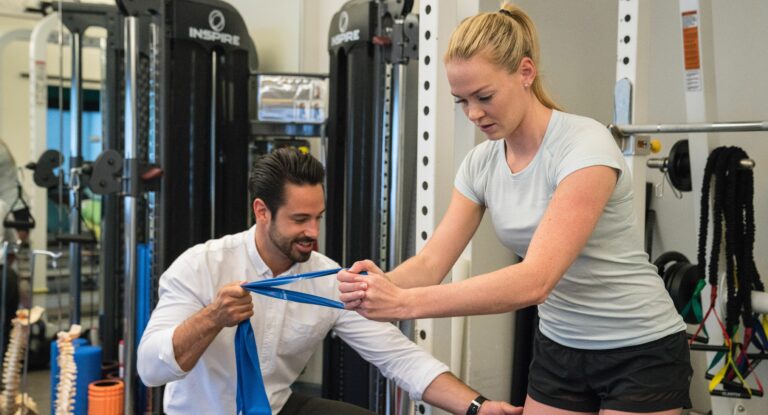Modern Solutions for Modern Problems
The COVID-19 Pandemic has affected every part of our lives. Those suffering and requiring ongoing care don’t deserve to be abandoned to their own devices while we practice self-isolation and social-distancing. In an effort to combat the effect of the pandemic on services people depend on, we have taken steps to be able to continue helping our patients.
During the clinic closure due to COVID-19 we will be offering telehealth remote care options for the following services:
- Physiotherapy
- Chiropractic
- Kinesiology
- Registered Dietitian
- Registered Psychology
Telehealth enables practitioners to continue delivering high-quality and convenient care to patients while they recover in the comfort of their own home. Software and program integrations allow us to support patients as they carry out their treatment plans at home safely and effectively without the need to enter the clinic during these times of elevated caution and risk management.

We are striving to keep integral services accessible by keeping sessions economically viable for everyone. With reduced rates compared to in-clinic services and forced emphasis on home-exercise programs reducing the frequency of necessary visits, financial barriers presented by the pandemic can be mitigated. Studies have shown that by eliminating barriers to care, telehealth improves outcomes for patients of all types.
Continuity of care and consistent assessment and feedback are integral in any therapy program and we are striving to continue to provide both during these trying times. Modern problems call for modern solutions and our advanced online systems allow us to continue helping patients while they are quarantined at home during this healthcare crisis.

Telehealth services give patients access to experts in their fields from the safety of their home. This allows them to receive:
- assessment by a clinician for an acute incident or chronic condition
- education about your diagnosis and ways you can limit aggravating factors in your day to day life
- tools to support recovery including activity modifications, ergonomic adjustments and lifestyle changes
- personalized rehabilitation exercise programs structured to meet their specific therapeutic goals
Technological Requirements
In general, telemedicine software is designed to be as easy to use as other familiar modern applications. Patients with a basic familiarity with online apps should be able to quickly figure out how to use our telehealth application.
Privacy

Because patient information and video are being transmitted, telemedicine software is required to be HIPAA-compliant. Our programs are encrypted to protect patient confidentiality unlike consumer grade applications like Skype and FaceTime.
Billing
Worksafe has announced they will be allowing billing for telehealth services and we anticipate ICBC is not far behind. Most major insurance providers may cover these sessions as well but we recommend confirming with them first that your specific plan will cover Telemedicine appointments. Don’t have extended health? Our Telehealth appointments are significantly more affordable than in-clinic sessions and often require less frequent appointments due to the emphasis on home active care. This makes our Telehealth services more financially accessible for everyone. Unfortunately, due to limited administrative support, we are unable to offer direct billing at this time. To avoid the need for physical transactions, payments are made via e-transfer for which you will receive a receipt that can be submitted to your extended health provider.
Integrated
Our telehealth services are integrated with our online booking and charting system, Jane. This allows easy setup and continuity for clients and a practitioners alike. Our platform allows practitioners to work cohesively with each other to best coordinate your treatments without the need for meeting face to face.
Applying the use of Telehealth to Registered Psychology and Registered Dietitian services is quite easy to imagine. Because both services revolve around verbal communication with limited usually no physical components they lend quite well to being offered on a remote platform. But what about physical medicine?
Applications of Telehealth for Physical Medicine
– Physiotherapy, Chiropractic & Kinesiology –

Follow-up Appointments
Using telehealth for routine follow ups provides a safe option by limiting physical interaction and crowded clinics. Assessment, clinical updates, therapeutic guidance and exercise prescription can all take place safely and efficiently from the comfort of your own home.
New Injury Assessments
Telehealth allows for remote assessment of new injuries with partial subjective physical examination and appropriate clinical guidance. If necessary, the practitioner will refer for more detailed assessment for more complex issues. For qualifying patients, they will progress to informed consent, clinical guidance and exercise prescription and be introduced to their rehabilitation schedule.

Chronic condition management
Patients with chronic conditions may require a short period of intensive therapy, followed by long-term care to sustain wellness. The use of telehealth makes it easier and less expensive for patients to maintain control over their health.
Orthopedics
Diversified orthopedic physical therapy focuses on treating conditions affecting the musculoskeletal system, including joints, muscles, bones, ligaments, and tendons by physiotherapists, chiropractors and kinesiologsts. Video visits can be used to guide patients through strengthening, flexibility, balance, and functional mobility exercises to recover from surgery or address chronic conditions.
Geriatric Care
Remote physical therapy is a particularly attractive option for high-risk older patients with conditions that affect their mobility and physical function, including arthritis, osteoporosis, hip and joint replacement, and balance disorders. Video visits reduce the burden on both patients and caregivers while limiting the potential exposure to COVID-19.
Post-Surgical and Post-Hospitalization Care

Physical therapy is often necessary following orthopedic surgeries and other hospitalizations. Video visits eliminate the need for travel during a time when patients may have limited mobility and higher susceptibility to the COVID-19 virus.
Sports Medicine
Therapists in sports medicine use telemedicine software to facilitate the diagnoses, treatment, and prevention of sports-related injuries both on and off the field.

Neurological Pathologies
Physical therapy is critically important for patients who have neurological diseases or injuries. With remote physical therapy following a neurological injury, patients can preserve or regain many functions, improve their ability to perform activities and enjoy independence without the cost and risks of in-office care.
What does a Telehealth Initial Appointment Look like?
- Quick Chat – Just like any face to face initial appointment in the clinic, the telehealth session will start with a discussion about health history and the nature of your primary complaint.
- Remote Physical Exam – The practitioner will then guide you through a remote physical assessment including basic movement screening and orthopedic testing to assess the issue.
- Referral if Necessary – If the practitioner deems that your complaints warrant a referral for more detailed in-house assessment and potential diagnosis of more complex conditions, they will referral you to the appropriate professional and you will not be billed for the session.
- Informed Consent – If the practitioner decides you qualify and will benefit from a Telehealth treatment plan, they will walk you through your assessment findings, potential prognosis, risks and rewards of telehealth therapy, therapeutic goals and treatment plan.
- Therapeutic Guidance – After receiving informed patient consent the practitioner will then educate and advise the patient of activity modifications, ergonomics and any additional clinical guidance that will aid in recovery.
- Exercises – Your practitioner will then introduce your at-home therapy program. They will take you through each exercise or practice so that you thoroughly understand every aspect of your routine. They will then give you an updated program via physitrack with video guidance and PDF downloads that you will complete on your own until your next appointment.
FAQ’s
Which patients are best suited for telehealth?
Patients who were in the middle of a treatment plan or who have seen our therapists before are the best candidates for Telehealth services. Because they have already have a comprehensive physical examination in person, therapists and clinicians are familiar with their diagnosis and can more thoroughly provide clinical guidance. That being said, new patients with complaints that are not complex in nature can also be good candidates for Telehealth services. We encourage all new patients seeking care to book an initial consultation and if we deem your issues too complex or requiring additional diagnostics, we will refer you to the appropriate professional and not charge you for the session.
Will patients receive the same quality of care?
Some of the most important aspects of therapy involve the conveyance of information about a patient’s diagnosis, factors that can aggravate or alleviate symptoms and the application of therapeutic exercises. While hands-on manual therapy can play a large role in some patient’s recovery, studies have shown that ensuring a patient understands their injury, clinical goals and therapeutic process can have just as much of a positive impact. Understanding your pain can have a direct affect on the level of discomfort you are experiencing. Not only will our clinicians and therapists thoroughly walk you through their clinical guidance but they will also leave you with a wealth of tools and resources to ensure proactive self-care between your sessions. For physical medicine services you will also have the added benefit of using the integrated Physitrack system for personalized at-home therapeutic exercise programs.
Will extended health insurance pay for telehealth visits?
Worksafe has agreed to allow telehealth services to be billed and we anticipate ICBC is close behind them. Major extended health providers will usually accommodate telehealth services but we encourage you to check with them prior to booking your appointments. For those who aren’t covered, rates are significantly reduced from in-clinic services to ensure no patient is left without options. Let us know you would like to be as financially efficient as possible and we will do our best to ensure you get a longstanding plan of action to help you recover with limited sessions.
What type of technology and devices are needed to use telehealth services?
We encourage patients to use a desktop computer or laptop with a webcam if possible. Being able to access their exercise plan in real time in a separate window can be helpful during the sessions. If no computer is available, patients can also use I-pads or smartphones for video calls.